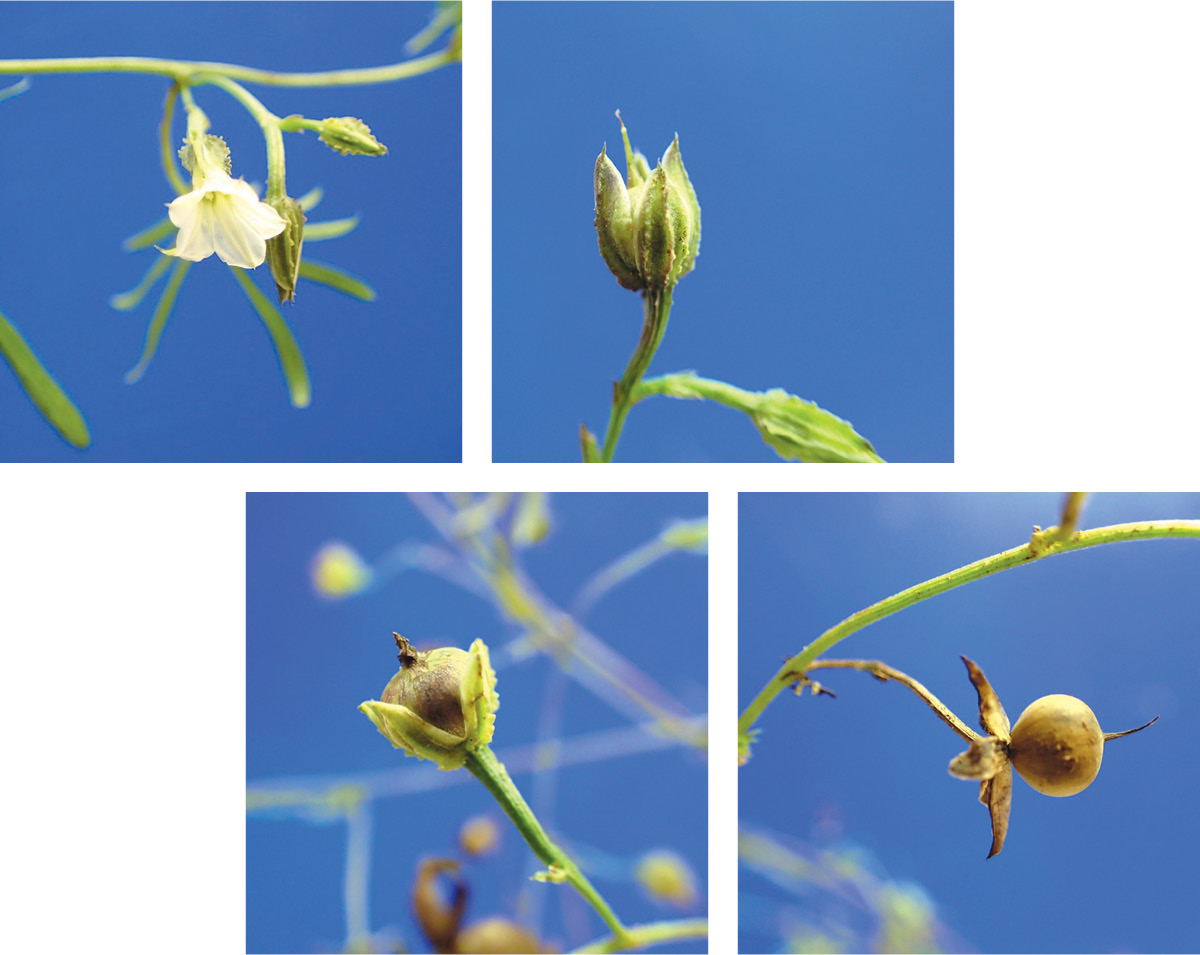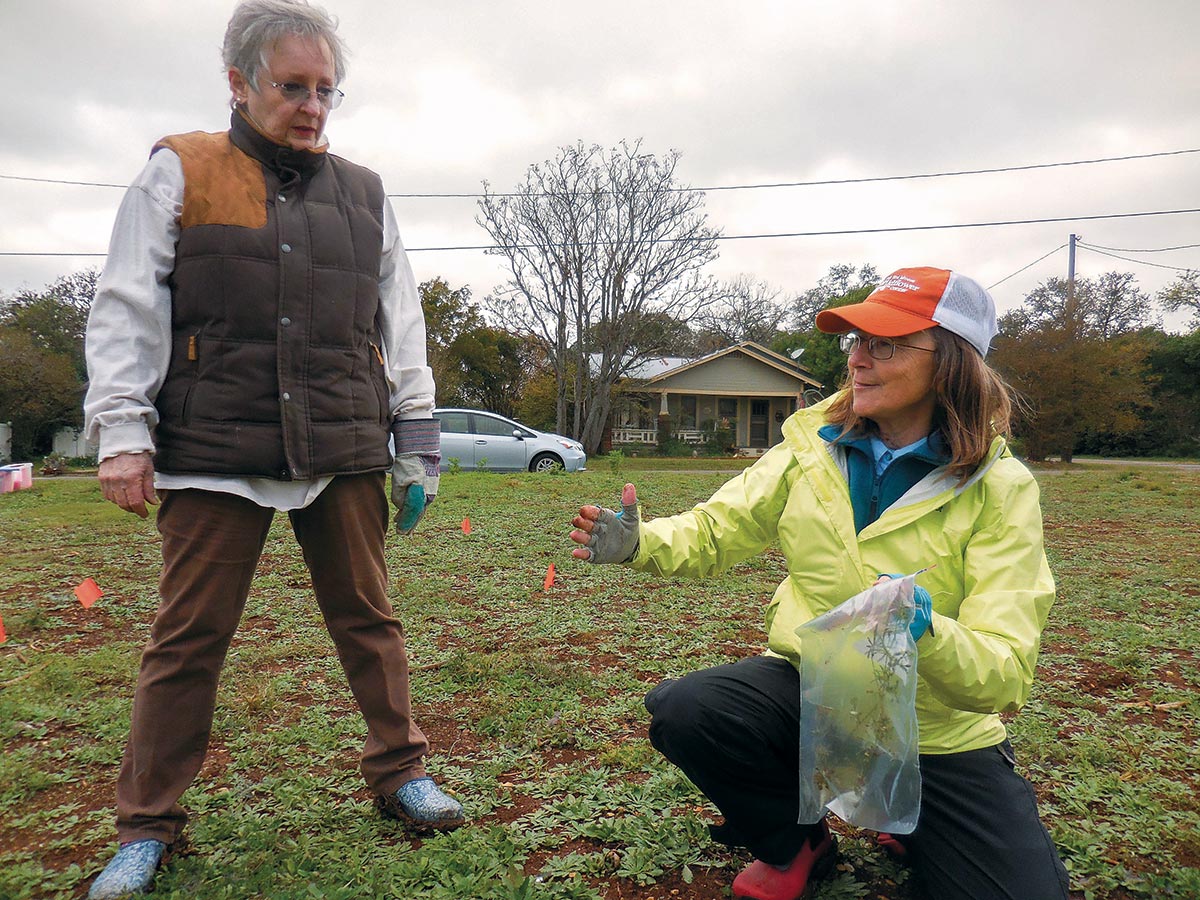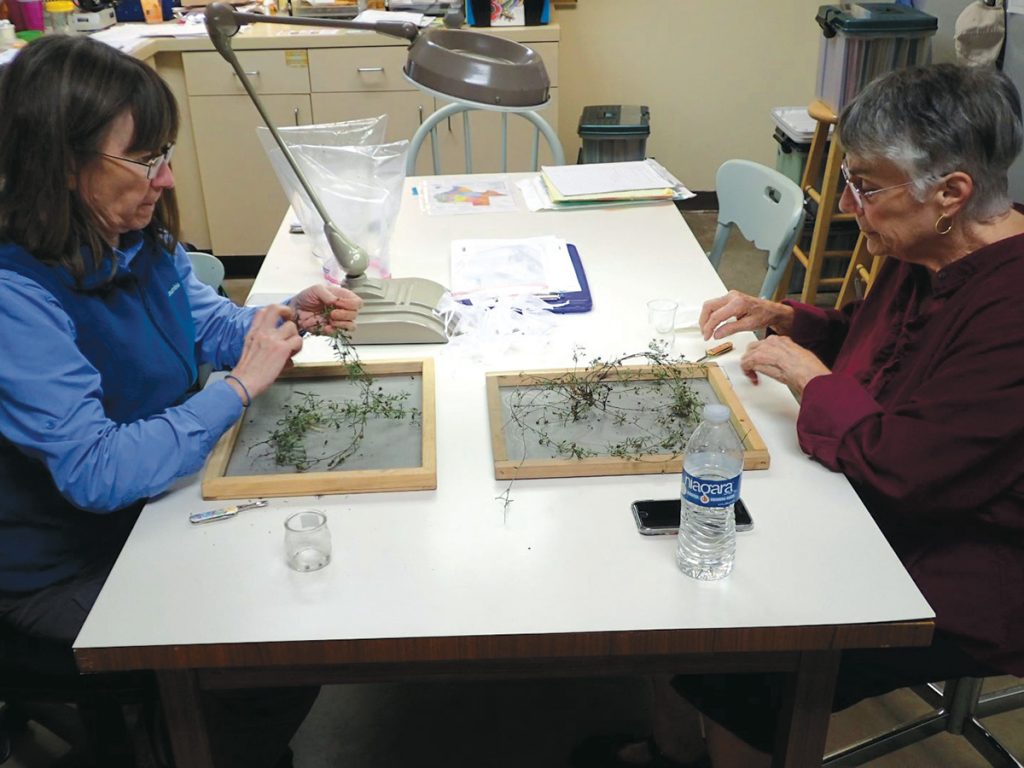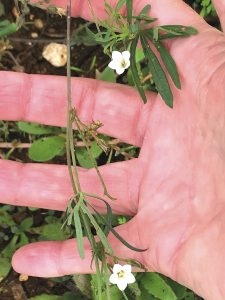New Plant on the Block

Edwards Plateau crestrib morning-glory PHOTO Sheryl Smith-Rodgers
As a Texas Master Naturalist, I have a keen eye for native plants. So when a tiny flower caught my attention last November, I stooped down for a closer look. Little did I know that my curiosity would set a botanic ball into motion and ultimately help to preserve a little-known native plant.
Flowers bloom every spring in a vacant lot adjacent to Trinity Lutheran Church in Blanco, Texas, where I live. When I heard the lot was targeted to be paved over, I asked Pastor Dayna Leggett if we could dig up plants, specifically non-native grape hyacinth (Muscari botryoides). I knew they grew there because I’d seen their blue bunch-flowers the previous spring. Before we met up, I scouted the lot for any native plants we might rescue too. My survey turned up prairie verbena (Glandularia bipinnatifida), littleleaf sensitive briar (Mimosa microphylla), buffalo bur (Solanum rostratum) and a mystery vine with pea-sized white blooms.
Intrigued, I snapped photos of the vine and emailed the images to two fellow naturalists I consider to be plant-ID experts. “Sorry,” they wrote back, “this one’s unfamiliar.” That night, I mulled over the photos. The seed capsule reminded me of a morning-glory while the narrowly lobed leaf shape rang a bell … but I couldn’t pinpoint why.
I couldn’t give up either. For the next hour, I skimmed through observations of morning-glory species found in Texas on iNaturalist. Finally, I hit the jackpot: My vine was a crestrib morning-glory (Ipomoea costellata). It had to be.
As a cross reference, I brought up crestrib morning-glory on the Wildflower Center’s online database, Native Plants of North America, and found only three images. I decided I’d submit photos since I’m a registered contributor. The next day, I returned to the vacant lot and took high-resolution photographs, which I emailed to Joe Marcus, the Native Plants of North America program coordinator (and this magazine’s plant information editor).
That’s when things took an unexpected turn.
“When I looked at Sheryl’s photos, I knew she’d found an uncommon species that I’d never even seen before,” says Marcus. “Right away, I checked our database but found little information.”
Marcus asked me if I could collect seeds or plants. Thankfully, I had the church’s permission to do so, but I also knew I’d need help. Enter Minnette Marr, the Center’s conservation program manager. After Marr got on board, my discovery grew even more interesting.

Dayna Leggett and Minnette Marr collect specimens in Blanco, Texas. PHOTO Sheryl Smith-Rodgers
“As part of my job, I work with landowners and organizations to collect seeds of uncommon wildflowers so we can bank them for future research,” explains Marr. Like Marcus, she was struck by my photos. “Through the years, I’ve botanized quite a bit in Hays and Blanco counties,” says Marr, “and I’d never seen that wildflower before.”
Marr looked at Ipomoea costellata’s distribution and saw noncontiguous populations. A bit more research, and she felt certain that “my” vine was a botanical variety called Edwards Plateau crestrib morning-glory (Ipomoea costellata var. edwardsensis). This distinct plant with white flowers was described in 2002 by researchers Robert O’Kennon and Guy Nesom in the journal SIDA, Contributions to Botany (published by the Botanical Research Institute of Texas).
Marr checked the Center’s seed bank and found that no seeds had been collected for this species. As soon as she could, she scheduled a trip to Blanco.
The next week, Marr met me, Leggett and my husband at the church property. Under cloudy and cold conditions, we staked vines with surveyor’s flags, focusing on those with mature seed capsules. In two hours, we pulled and bagged 47 plants, which are annuals. Marr also collected voucher specimens (those meant to be preserved), which have been submitted under my name to herbaria at the Wildflower Center and The University of Texas at Austin. How cool is that?

Marr and volunteer Charlene Farris select and remove mature capsules in
the Wildflower Center Herbarium. PHOTO Tyler Thompson
Back at the Wildflower Center, the more intensive, patience-requiring work began. For several weeks, Marr and conservation program volunteers processed vines and seeds. She details their efforts to maximize the harvest: “We placed plants with immature capsules in water to allow them to grow two weeks more; we air-dried vines with mature capsules on screens; we harvested seeds from mature capsules and placed them in separate mesh bags.” Marr says the seeds will be stored for future research and distributed to landowners
in the wildflower’s native range.
In the meantime, Marcus obtained a unique code for the Edwards Plateau crestrib morning-glory from the folks at USDA PLANTS (in botanic shorthand, it is now “IPCOE”). This allowed him to enter a new record in the Center’s plant database. Wow, I thought, I helped make that online page — exactly the type of resource I use so often — happen. (USDA PLANTS will eventually add the taxon to its database too.)
Throughout our rescue efforts, I observed how passionate Marr and Marcus are about their work to protect native plants. “I have a tender spot for little known plants, and these vines don’t turn up in many places,” Marcus told me. “They deserve to be appreciated where found, protected where possible, and rescued where necessary so they can have a fighting chance to survive.”
Though I’m no expert, I share their passion. After all, it’s what piqued my interest in a little white flower in the first place. Together, we three demonstrated how citizen scientists can partner with professionals to further the Center’s mission to conserve native plant species. Without similar collaborative efforts, overlooked native plants like the Edwards Plateau crestrib morning-glory could be lost. And that’s one story I never want to tell.
Learn more about contributing photos to Native Plants of North America.

Edwards Plateau crestrib morning-glory PHOTO Sheryl Smith-Rodgers
AT A GLANCE
Edwards Plateau crestrib morning-glory (Ipomoea costellata var. edwardsensis)
• Clambering annual vine with one to five stems
• Trails up to 2 feet in length
• White flowers bloom August through November
• Endemic to the Edwards Plateau
• Grows in shallow soil on limestone and granite substrate, particularly in areas protected from grazing animals
• Occurs in Bexar, Blanco, Burnet, Gillespie, Llano, Travis and Uvalde counties
Sheryl Smith-Rodgers is a writer, photographer and Texas Master Naturalist. She lives in Blanco, Texas, and blogs about her native plant garden at Window on a Texas Wildscape.

